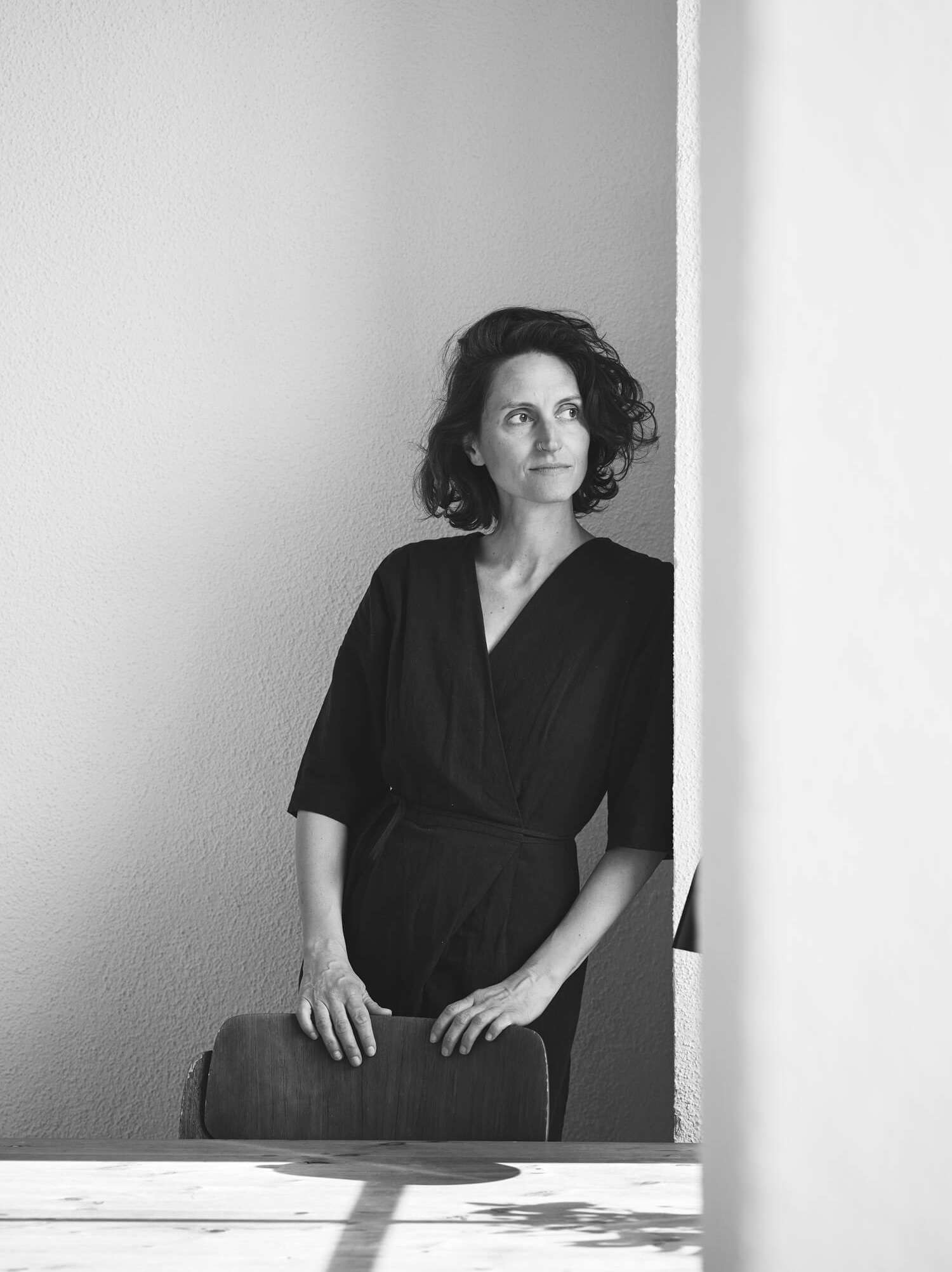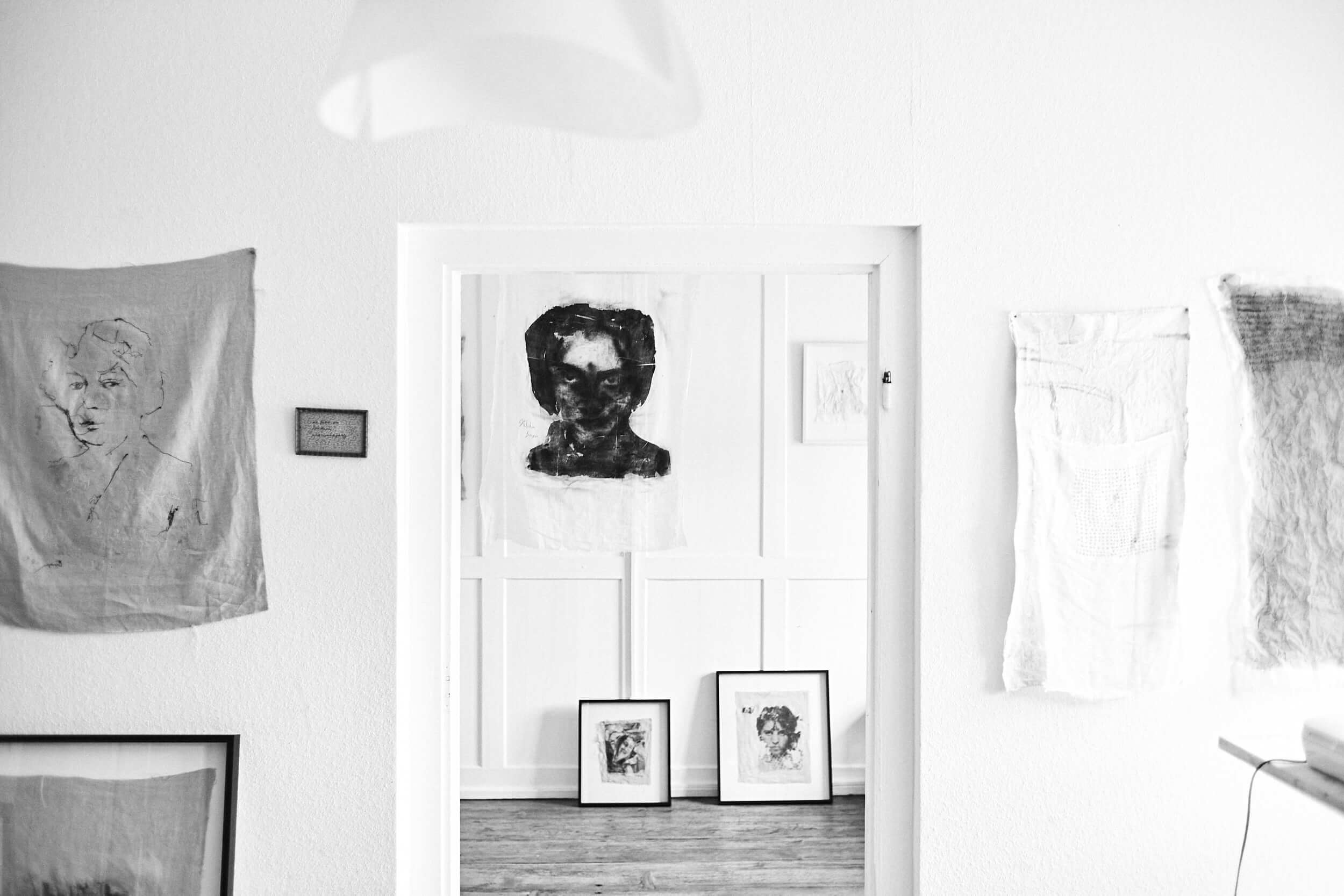Bianca Lugmayr delves deeply into language
, materiality, and abstraction in her work. Her signature is the fast, freely sewn line that represents liberation from perfectionism, raw beauty, and the value of imperfection.
In her graphic text works, the act of creation itself – the force of the sewing machine needle perforating the fabric – intensifies the power of the repetitively written words. Common to all her works is the line and the textile grid as visual tools.
Biography
Born 1979 in Wels and lives and works as a freelance artist in Vorarlberg. She studied pharmacy at the University of Innsbruck as well as textile/art and design at the University of Arts Linz under Marga Persson and cultural management at the Institute for Cultural Concepts in Vienna.
Bianca Lugmayr

Selected Exhibitions
2025
Dye Dynamite, Pulverturm Feldkirch, AT (Solo)
Unterm Teppich, Palais Thurn und Taxis, Bregenz, AT (Group Show)
Städtische Galerie Fauler Pelz, Überlingen, DE (Group Show)
Rethinking Tradition, Landestheater Bregenz, AT (Group Performance Show)
I am my own muse, Klocker Museum, Hall i.Tirol, AT (Group Show)
2024
Kleine Formate, Villa Claudia Feldkirch (Group Show)
Vault.Sewing. Trumpet (Duo)
Rethinking.tradition, Südtirol – Vorarlberg (Group Performance Show)
Zollart Textile Intervention, Koblach (Solo)
Poststelle Schwarzenberg (Solo)
2023
Galerie Z, Hard (Solo)
Galerie 9 und 20, Bregenz (Solo)
Emsiana, Hohenems (Group Show)
Alle, Palais Thurn und Taxis, Bregenz (Group Show)
2022
Unterm Strich, Villa Claudia, Feldkirch (Group Show)
Schiele Award 2022, Minoritenkloster, Tulln (Group Show)
Wenn Material zur Form wird, Artenne Nenzing (Group Show)
Kunsthotel Hirschen Schwarzenberg (Solo)
Heimspiel 2021, Feldkirch (Open Studio)
Gesponnen, bemessen, beschnitten, Kollektiv, Bregenz (Solo)
Warum Kunst, Palais Thurn und Taxis, Bregenz (Group Show)
Wechselspiel, Zollart Schauraum, Koblach (Group Show)
2021
Vom Schatten ans Licht, Musica Femina, Wien (Solo)
Round 72, Bregenz (Group Show)
Feministival 2021, Chybulski, Feldkirch (Group Show)
Residency, Borgo Museo di Pistoia, Castagno di Piteccio, Italy
Kunstlager II, Villa Claudia, Feldkirch (Group Show)
An Vogel, Palais Thurn und Taxis, Bregenz (Group Show)
2020
Augentrost, ORF Funkhaus, Vorarlberg (Group Show)
Geburtskultur, Frauenmuseum, Hittisau (Group Show)
2019
Chybulski, Feldkirch (Solo)
Was berührt Dich?, Alte Seifenfabrik, Lauterach
Art prize and Collections
Sammlung Illwerke VKW
Sammlung Land Vorarlberg
Nominierung Schiele Award 2022
Frauenkunstförderpreis der Anne Goldenberg Stiftung
Member
Künstlerhaus Vereinigung Wien
Kunst Vorarlberg
Berufsvereinigung bildender Künstlerinnen und Künstler Vorarlbergs
IG Bildende Kunst Wien
Text
— by Peter Niedermaier
With the inspirations from life we have arrived at opening and concealing. Right down to the last ramifications, down the very tips. Here we research the orbits of the inner planets and the happiness of involuntary memories. One writes in order to be loved. Where, in any case, there is nothing to know. There is no renunciation without speculation about a subsequent gain. What is useful for itself? And what happens in turning over? And why do we sew? We know the stories, the invented and speculative ones, the absurd and sorrowful ones, we know Penelope who waits for Odysseus and tells the men who desire her that she wants first to finish weaving the big carpet. and she does this. But every evening she unravels the work she has done during the day, as she does not want to come to an end. Does art follow life or life art? Much grows heated through textiles and through art. The indifferent and the desirable and all the shades between with and without patterns. And writing? Writing is a mode of the rhetoric, as T. S. Eliot says, an affection for the world, for the ideal. And what is sewing? Like with writing, it is giving an indication of oneself, linking networks. A part of existence. Because there is not anything to know. Sewing is an aesthetic experience. An intertextual connotation. Imaginary research. The essence of love is disillusion. Writing and sewing are its sensual longing. A game with language. An unmasking. As original social critique. Finding what connects and expressing it in language, binding and joining with thread, putting together, not constricting. The sack dress is an advance into life, like the bike. Liberation from the corset.
Searching for the lost paradise. In the direction of the sunbeams in the afternoon, which extend into the early evening, like a fleeting beauty. An hour dissolved into details that stand for themselves. Realities in which one no longer believed or asked about. What remains is a form of simplicity. The style of the dress is like the style of the building. A very different one. And yet, essentially, related because reduced. An existential dwelling. As a paradox of the present. The most beautiful books are written like the most beautiful clothes. Texted clothing. With a turn the artist suggests seeing the dress of life from the end, wide and open, tolerating the parlour. Seeing the dress reflected in life, quenching the thirst of the day. Just as each kiss awakens the next one, like flowers in a meadow in May. One can only lose the thread respectfully if one looks at art like love, without illusions. Life in an infinite script and an infinite thread. What remains in art, actually, is the dream text. The skin-like quality as a canvas for the ideas of the mysterious.
Peter Niedermair
Translated by James Roderick O’Donovan
— by Anne Zühlke
On a Path with the Line
Living Words


“A look at the current work of Austrian artist Bianca Lugmayr, who lives in Vorarlberg, reveals a change in her artistic practice which has moved from the figurative works of the early years to an intensive study of language, materiality, and abstraction. The earlier themes – an examination of femaleness, the confrontation with the uncertainties of mundane life and the need to give the internal life a visual expression – still remain evident, while since 2021 her formal language has undergone a consistent self-critical renewal.
The collages of strong female figures using a mix of materials such as photographs, print and decorative textile elements on linen or paper, whose strengths, courage, and lives served Lugmayr as metaphors of an autonomous and combative female way of living, give way to the line and the textile grid as artistic means.”
— Anne Zühlke
Selected Work
Image Credits: Angela Lamprecht, Ivo Vögel Fotografie
Bianca Lugmayr delves deeply into language, materiality, and abstraction in her work. Her signature is the fast, freely sewn line that represents liberation from perfectionism, raw beauty, and the value of Imperfection.